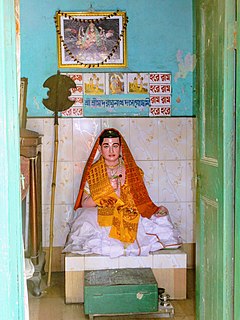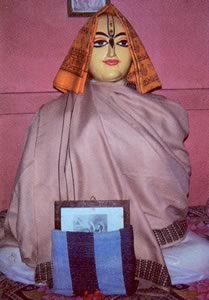
Chaitanya Mahaprabhu was a 15th-century Indian saint who is considered to be the combined avatar of Radha and Krishna by his disciples and various scriptures. Chaitanya Mahaprabhu's mode of worshipping Krishna with ecstatic song and dance had a profound effect on Vaishnavism in Bengal. He was also the chief proponent of the Vedantic philosophy of Achintya Bheda Abheda Tattva. Mahaprabhu founded Gaudiya Vaishnavism. He expounded Bhakti yoga and popularized the chanting of the Hare Krishna Maha-mantra. He composed the Shikshashtakam.

Gaudiya Vaishnavism, also known as Chaitanya Vaishnavism, the Bengali, Chaitanya or Gaudiya Sampradaya, Chaitanyaism, and Gaura Dharma.</ref> is a Vaishnava Hindu religious movement inspired by Chaitanya Mahaprabhu (1486–1534) in India. "Gaudiya" refers to the Gaura or Gauḍa region of Bengal, with Vaishnavism meaning "the worship of Vishnu". Specifically, it is part of Krishnaism—Krishna-centric Vaishnavite traditions.
Goswami is an Indian surname. The Sanskrit compound Goswami may mean "lord of the senses" or lord of the Vedas. It is also pronounced as Gosains, Gossain, Gosain, Gosavi and Gossains.

Pudukkottai is the administrative headquarters of Pudukkottai District in the Indian state of Tamil Nadu. It is a large city located on the banks of the Vellar River. It has been ruled, at different times, by the Cholas, Early Pandyas, Thondaimans, and the British. It is situated about 395 kilometres (245 mi) southwest of the state capital Chennai and about 55 kilometres (34 mi) southeast of Tiruchirappalli. Tamil Nadu's first woman Asian Games competitor, Santhi Soundarajan, is from Pudukkottai.
The Chaitanya Charitamrita, composed by Krishnadasa Kaviraja in c. 1557, is written in Bengali with a great number of Sanskrit verses in its devotional, poetic construction, including Shikshashtakam. It is one of the primary biographies detailing the life and teachings of Caitanya Mahāprabhu, the founder of Gaudiya Vaishnavism. The stories of Chaitanya's life are mixed with philosophical conversations detailing the process of Bhakti yoga, with special attention given to congregational chanting of Krishna's names and the Hare Krishna mantra.

Rupa Goswami was a devotional teacher (guru), poet, and philosopher of the Gaudiya Vaishnava tradition. With his brother Sanatana Goswami, he is considered the most senior of the six Goswamis of Vrindavan associated with Caitanya Mahaprabhu, a hidden avatar (incarnation) of Krishna in Kali Yuga.
Raghunatha Bhatta Goswami (1505–1579) was a well known follower of the Vaishnava saint Chaitanya Mahaprabhu, and member of the influential Gaudiya Vaishnava group collectively known as the Six Goswamis of Vrindavan. He is regarded by followers in the Gaudiya tradition as an ideal practitioner of the Bhakti yoga system.

Gopala Bhatta Goswami (1503–1578) is one of the foremost disciples of the Vaishnava saint, Chaitanya Mahaprabhu, and a leading historical figure in the Gaudiya Vaishnava school of Hinduism. He was part of a group of Vaishnava devotees known collectively as the Six Goswamis of Vrindavan, who were influential in establishing the philosophical basis of the Gaudiya tradition in formalised writings.

Raghunatha dasa Goswami (1494–1586), a.k.a. Dasa Goswami, was a disciples of the Śrī Yadunandan-ācārya one of the apostle of the Vaishnava saint, Chaitanya Mahaprabhu, the primary six of which were collectively known as the Six Goswamis of Vrindavan. Together the Six Goswamis established the philosophical writings and records which became the theological basis of the Gaudiya Vaishnava tradition. Among the six, Raghunatha dasa was renowned for his qualities of simplicity and renunciation.

Haridasa Thakur was a prominent Vaishnava saint known for being instrumental in the initial propagation of the Hare Krishna movement. He is considered to be the most famous convert of Chaitanya Mahaprabhu, apart from Rupa Goswami and Sanatana Goswami. His story of integrity and unflinching faith in the face of extreme adversity is told in Chaitanya Charitamrita, Antya lila. It is believed that Chaitanya Mahaprabhu himself designated Haridasa as nāmācarya, meaning the 'teacher of the Name'. Haridasa Thakura, was a devotee of God, Krishna, and had practiced chanting the names of the Lord, Hare Krishna, 300,000 times daily.

Pudukkottai was a kingdom and later a princely state in British India, which existed from 1680 until 1948.

The Thondaimans are chieftains who ruled the region in and around Pudukottai from the 17th to 20th century. The Pudukkottai Thondaiman dynasty was founded by Raghunatha Thondaiman, the brother-in-law of the then Raja of Ramnad, RaghunathaKilavan Setupati. The Pudukottai Samasthanam was under Thondaiman dynasty for one year even after Indian Independence. The Thondaiman dynasty had a special Valari regiment.
Raja Sri Brahdamba Dasa Raja Sri Rajagopala Tondaiman Bahadur was the ninth and last ruler of the princely state of Pudukkottai.

The Tondaiman family were Tamil rulers of the ancient Tondai Nadu (Tondaimandalam) division of Tamilakkam in South India. Their capital was at Kanchipuram.
Raja Sri Raghunatha Tondaiman Bahadur was the ruler of the princely state of Pudukkottai from 4 June 1825 to 13 July 1839.
Vijaya Raghunatha Raya Tondaiman was the ruler of the princely state of Pudukkottai from 1 February 1807 to 4 June 1825.
Raja Sri Vijaya Raghunatha Tondaiman Bahadur was the ruler of the pudukottai kingdom from 30 December 1789 to 1 February 1807.
Vijaya Raghunatha Raya Tondaiman may refer to
The Six Goswamis of Vrindavan were a group of devotional teachers (gurus) from the Gaudiya Vaishnava tradition of Hinduism who lived in India during the 15th and 16th centuries. They are closely associated with the land of Vrindavan where they spent much time in service of the Bengali saint Chaitanya Mahaprabhu, who is considered as Krishna's yuga-avatar by the Gaudiya Vaishnava lineage, who highly regard them for their extreme renunciation of physical comforts and pleasures in the practice of Bhakti Yoga, and for their philosophical presentations of the teachings of their guru, Chaitanya Mahaprabhu.








